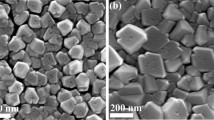Abstract
Nickel allows to study the largest variety of phenomena in the magnetism of UHV ultrathin films. The low critical temperature of ≈ 630 K for the bulk favors experiments from 0 K to aboveT c and from one monolayer to infinite thick films. The thickness dependence ofT c (d) for the (001) and the (111) orientation is compared. Susceptibility measurements in UHV are presented, and from χmax the film geometry can be deduced. Ferromagnetic resonance measures the second- and fourth-order anisotropy constants. These give a clear understanding of when and how the reorientation transition from the in-plane to the perpendicular orientation occurs and its nature. Magnetic resonance and circular X-ray dichroism measure the spin and orbital parts of the magnetic moment µ, its anisotropy Δµ, and the 3d and 4sp contributions. Finally, we show how a 4 Monolayer (ML) Ni(001) film can be transformed into NiO by controlled oxygen dosage and thermal treatment.
Similar content being viewed by others
Reference
L. Néel: J. Phys. (Paris) Radium15, 225 (1954)
U. Gradmann: Ann. Phys.17, 91 (1966)
U. Gradmann: InHandbook of Magnetic Materials, Vol. 7, ed. by K.H.J. Bushow (Elsevier, Amsterdam 1993) Chap. 1
B. Heinrich, J.A.C. Bland:Ultrathin Magnetic Structures I, II (Springer, Berlin, Heidelberg 1994)
See, for example: L.J. de Jongh, A.R. Miedema: Adv. Phys.23, 1 (1974)
Y. Li, K. Baberschke: Phys. Rev. Lett.69, 1209 (1992)
R. Bergholz, U. Gradmann: J. Magn. Magn. Mater45, 389 (1984)
See, for example: D.K. Wohlleben, B.R. Coles: InMagnetism V, ed. by G. T. Rado, H. Suhl (Academic, New York 1973)
T c may not be identical toΘ, for details see standard literature (e.g, Ref. [10])
J.J. Binney, H.J. Dowerick, A.J. Fisher, M.E.J. Neuman:The Theory of Critical Phenomena (Clarendon, Oxford 1992)
M. Tischer, D. Arvanitis, T. Yokoyama, T. Lederer, L. Tröger, K. Baberschke: Surf. Sci.307–309, 1096 (1993)
C. Rau, H. Huffner: J. Magn. Magn. Mater,54–57, 767 (1986)
C.A. Ballantine, R.L. Fink, J. Araya-Pochet, J.L. Erskine: Phys. Rev. B41, 2631 (1990)
F. Huang, G.J. Mankey, M.T. Kief, R.F. Willis: J. Appl. Phys.73, 6760 (1993), Phys. Rev. B49, 3962 (1994)
M. Tischer: Dissertation, FU Berlin (1995) (unpublished)
U. Stetter, M. Farle, K. Baberschke, W.G. Clark: Phys. Rev. B45, 503 (1992)
U. Stetter, A. Aspelmeier, K. Baberschke: J. Magn. Magn. Mater.117, 183 (1992)
M. Farle, K. Baberschke, U. Stetter, A. Aspelmeier, F. Gerhardter: Phys. Rev. B47, 11571 (1993)
R. Nickel: Diploma Thesis, FU Berlin (1995) (unpublished)
Following the relation µ = 1 + χ, we use χ in dimensionless (SI) units. However, care must be taken in defining the anisotropyK (Sect. 2). The literature uses the cgs system. In (5a), we write for the demagnetizing fieldNM (SI units), but in (9), we follow the literature and use 4πNM (cgs units)
A. Aspelmeier, F. Gerhardter, K. Baberschke: J. Magn. Magn. Mater.132, 22 (1994)
E.D. Tober, R.X. Ynzunza, C. Westphal, C.S. Fadley: Preprint (1995)
P.A. Beck: Solid State Commun.34, 581 (1980)
P.A. Beck: Phys. Rev. B23, 2290 (1981)
A. Aspelmeier, M. Tischer, M. Farle, M. Russo, K. Baberschke, D. Arvanitis: J. Magn. Magn. Mater.146, 256 (1995)
P.J. Jensen, H. Dreyssé, K.H. Bennemann: Surf. Sci.269/270, 627 (1992)
L.H. Tjeng, Y.U. Ydzerda, P. Rudolf, F. Sette, C.T. Chen: J. Magn. Magn. Mater.109, 288 (1992)
B. Schulz, R. Schwarzwald, K. Baberschke: Surf. Sci.307/309, 1102 (1994)
Landolt-Börnstein, Vol. III/19a, ed. by H.P.J. Wijn (Springer, Berlin, Heidelberg 1986)
See, for example: S. Chikazumi, S.H. Charap:Physics of Magnetism (Wiley, New York 1964)
Only single-domain phenomena are discussed. This is the actual case for ultrathin films. For multidomain effects see literature, e.g. Ref. [28]
B. Coqblin:The Electronic Structure of Rare-Earth Metals and Alloys: The Magnetic Heavy Rare-Earth (Academic, New York 1977)
A. Berghaus, M. Farle, Yi Li, K. Baberschke: InMagnetic Properties of Low-Dimensional Systems II, ed. by L.M. Falicov, F. Mejia-Lira, J.L. Moran-Lopez, Springer Proc. Phys., Vol. 50 (Springer, Berlin, Heidelberg 1990) p. 61
B. Schulz: Dissertation, FU Berlin (1995) (unpublished)
B. Schulz, K. Baberschke: Phys. Rev. B50, 13467 (1994)
R. Jungblut, M.T. Johnson, J. de Stegge, A. Reinders, F.J.A. den Broeder: J. Appl. Phys.75, 6424 (1994)
S. Müller, B. Schulz, G. Kostka, M. Earle, K. Heinz, K. Baberschke: Surf. Sci. (in press 1996)
T.H. Moos, W. Hubner, K.H. Bennemann: Preprint (1995)
C. Kittel, J.H. van Vleck: Phys. Rev.118, 1231 (1960)
E. Callen, H.B. Callen: Phys. Rev.139, A455 (1965)
G. André, A. Aspelmeier, B. Schulz, M. Earle, K. Baberschke: Surf. Sci.326, 275 (1995)
Yi Li: Dissertation, FU Berlin (1991) (unpublished)
E. Kneller:Ferromagnetismus (Springer, Berlin, Heidelberg 1962)
M. Blume, S. Geschwind, Y. Yafet: Phys. Rev.181, 478 (1969)
A.J.P. Meyer, G. Asch: J. Appl. Phys.32, 330 (1961)
P. Carra, B. Thole, M. Altarelli, X. Wang: Phys. Rev. Lett.70, 694 (1993)
F.M.F. de Groot: J. Electron Spectrosc. Relat. Phenom.67, 529 (1994)
J. Hunter Dunn, D. Arvanitis, N. Mårtensson, M. Tischer, F. May, M. Russo, K. Baberschke: J. Phys. Condens. Matter7, 1111 (1995)
F. Schreiber, J. Pflaum, Z. Frait, Th. Mühge, J. Pelzl: Solid State Commun.33, 965 (1995)
M. Tischer, O. Hjortstam, D. Arvanitis, J. Hunter Dunn, F. May, K. Baberschke, J. Trygg, J. M. Wills, B. Johansson, O. Eriksson: Phys. Rev. Lett.75, 1602 (1995)
F. May, M. Tischer, D. Arvanitis, M. Russo, J. Hunter Dunn, H. Henneken, H. Wende, R. Chauvistré, N. Mårtensson, K. Baberschke: Phys. Rev. B53, 1076 (1996)
W.L. O'Brien, B.P. Termer: Phys. Rev. B49, 15370 (1994)



